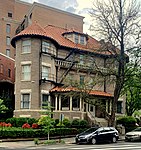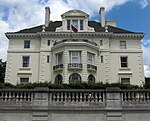Treaty Oak (Washington, D.C.)

The Treaty Oak was a 350–400-year-old oak tree that once stood on the Oak Lawn estate in Washington, D.C. The estate was previously called Widow's Mite and owned by the Holmead and Nourse families. It included a large four-story Second Empire house that owner Thomas P. Morgan had expanded. The estate was bounded by 19th Street, Columbia Road, Connecticut Avenue, and Florida Avenue, on the edge of today's Dupont Circle and Adams Morgan neighborhoods. The oak tree earned its nickname due to local legends that a treaty was signed there between early settlers and Native Americans. Despite massive development in the surrounding neighborhoods during the late 19th century and early 20th century, the estate remained a wooded area and was sought by local developers. In 1922 a Masonic group purchased the estate for what was then a significant amount of money to build a massive complex that would include temples. The plans were never carried out, and in 1940 the site was chosen for the large Crystal Heights mixed development designed by Frank Lloyd Wright. That plan was also abandoned. The tree remained until 1953 when it was felled for a planned commercial development. The land where the tree and house once stood is the site of the Washington Hilton, an apartment building, and two office buildings. At the time of its destruction, the Treaty Oak was reportedly the largest oak tree in the Washington, D.C. area.
Excerpt from the Wikipedia article Treaty Oak (Washington, D.C.) (License: CC BY-SA 3.0, Authors, Images).Treaty Oak (Washington, D.C.)
Connecticut Avenue Northwest, Washington
Geographical coordinates (GPS) Address Phone number Website Nearby Places Show on map
Geographical coordinates (GPS)
| Latitude | Longitude |
|---|---|
| N 38.916275 ° | E -77.044703 ° |
Address
Washington Hilton
Connecticut Avenue Northwest 1919
20009 Washington
District of Columbia, United States
Open on Google Maps








